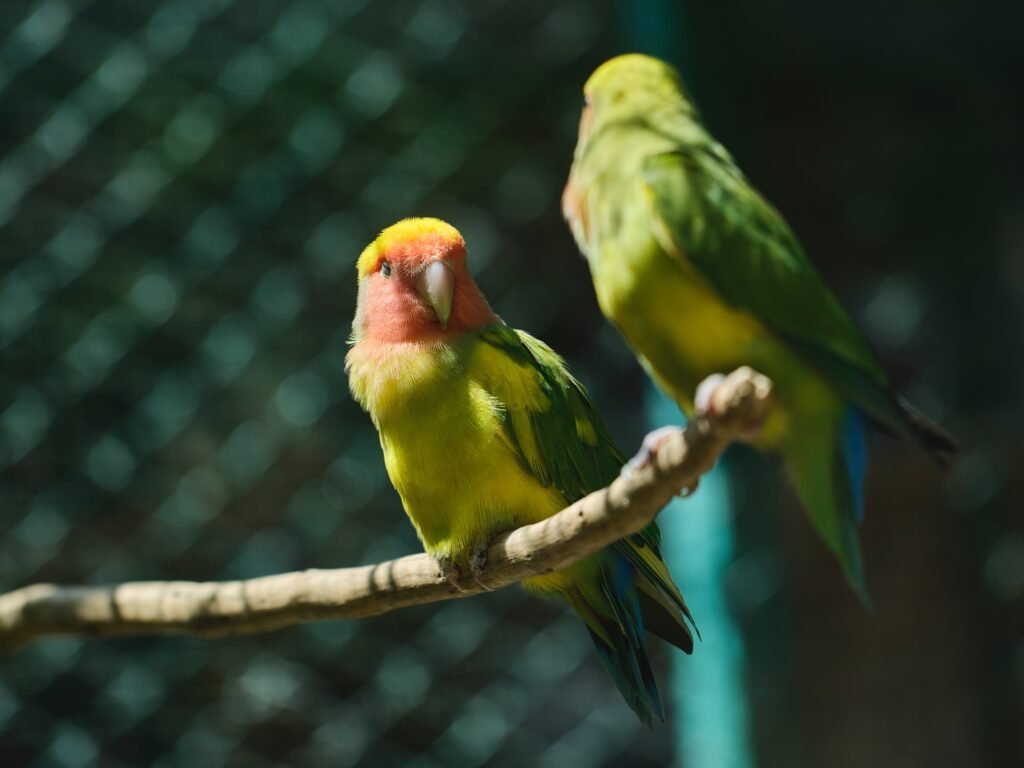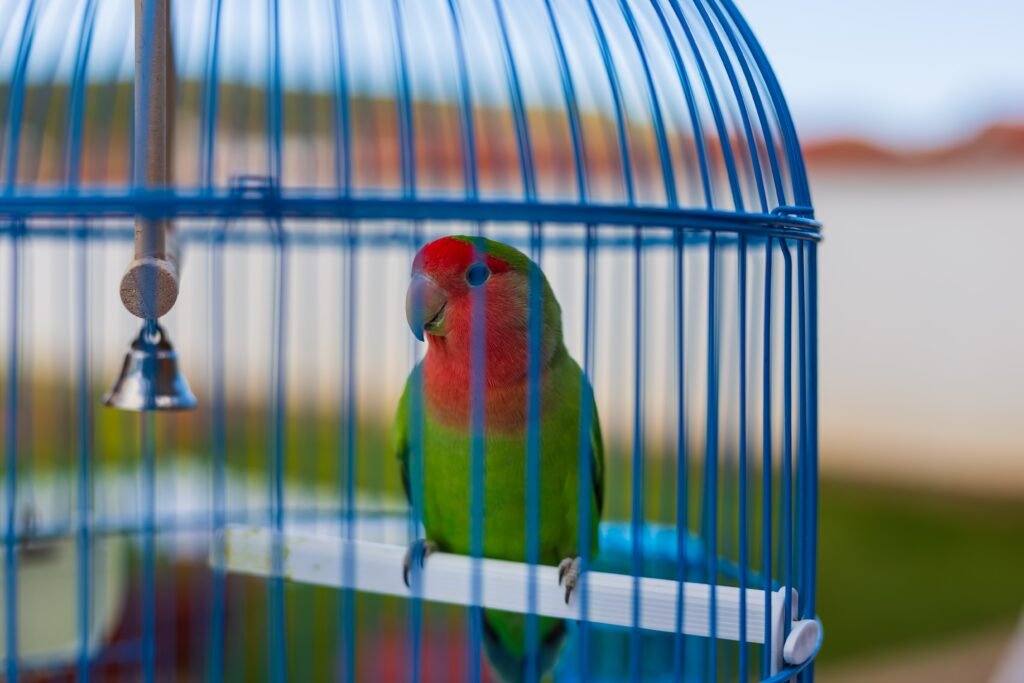Lovebirds are enchanting little parrots known for their vibrant colors, affectionate behavior, and captivating flight patterns. Watching lovebirds take flight is a mesmerizing experience that showcases their agility, grace, and natural beauty. In this article, we will delve into the fascinating world of lovebird flight, exploring their flight capabilities, aerodynamics, and the factors that contribute to their graceful soaring.
The Flight Capabilities of Lovebirds
Lovebirds possess impressive flight capabilities that allow them to navigate through their natural habitats with ease. Their strong wings and streamlined bodies enable them to soar through the air, covering considerable distances in search of food, water, and suitable nesting sites. Lovebirds are highly agile and can maneuver swiftly, swiftly changing directions in mid-air, making their flight appear effortlessly graceful.
Wing Structure and Adaptations
The wings of lovebirds are uniquely designed to facilitate their flight. They have long and curved wings, allowing for efficient lift and a broad range of motion. The shape of their wings creates an optimal balance between lift and agility, enabling them to perform intricate aerial maneuvers.
Lovebirds also possess strong flight muscles, which provide the power necessary for sustained flight. These muscles are particularly well-developed in their chest area, enabling them to generate the necessary force to propel themselves through the air.
Additionally, lovebirds have specialized feathers that contribute to their flight capabilities. Each feather is intricately designed, fitting together like a puzzle to form a smooth surface that minimizes air resistance. These lightweight yet robust feathers provide insulation, protection, and aid in flight control.
Feathers and Coloration
The vibrant colors of lovebird plumage play a role in their flight as well. While primarily an aesthetic feature, their colorful feathers also serve as a form of communication, allowing lovebirds to identify one another in flight and maintain flock cohesion. The bright hues of their feathers make it easier for lovebirds to spot their companions amidst the foliage or in the sky, ensuring they stay together during flight.
Moreover, the feather structure of lovebirds contributes to their flight capabilities. The lightweight nature of their feathers reduces the overall weight of the bird, making it easier for them to achieve lift and stay airborne. Additionally, the robustness of their feathers provides protection against wind resistance, allowing lovebirds to maintain their flight speed and maneuverability.
Aerodynamics of Lovebird Flight
The flight of lovebirds is governed by the principles of aerodynamics, which explain how objects move through the air. Understanding the aerodynamics of lovebird flight helps us comprehend their ability to stay airborne and perform aerial acrobatics.
Lift and Drag
Lift is a crucial force that enables lovebirds to defy gravity and remain airborne. As air flows over the curved surface of their wings, it creates a pressure difference, generating lift. This opposing force counters the pull of gravity, allowing lovebirds to soar and glide effortlessly.
Drag, on the other hand, is the resistance encountered by lovebirds as they move through the air. Minimizing drag is essential for lovebirds to maintain their speed and maneuverability. Their streamlined bodies, coupled with the sleek structure of their feathers, help reduce drag and enhance their flight efficiency.
Lovebirds’ wings are specifically designed to maximize lift and minimize drag. The curved shape of their wings allows for efficient air flow, creating a pressure difference that generates lift. This lift force enables lovebirds to stay airborne and perform their graceful flight patterns.
Soaring and Gliding
Lovebirds have the ability to soar and glide for extended periods. Soaring involves utilizing air currents, such as thermals, to gain altitude without flapping their wings. By finding rising pockets of warm air, lovebirds can conserve energy while remaining airborne. Gliding, on the other hand, allows them to cover horizontal distances with minimal effort by utilizing the forward momentum gained during a descent.
During soaring, lovebirds take advantage of rising air currents to gain altitude. These air currents, such as thermals, are created by the heating of the earth’s surface, causing warm air to rise. Lovebirds can effortlessly soar within these thermals, using the upward air movement to stay airborne without flapping their wings.
Gliding, on the other hand, involves utilizing the forward momentum gained during a descent to cover horizontal distances. Lovebirds can glide by spreading their wings and adjusting their body position to catch the air currents, allowing them to travel long distances with minimal energy expenditure.
Factors Affecting Lovebird Flight
Several factors impact the flight abilities of lovebirds, influencing their flight patterns, speed, and overall maneuverability.
Habitat and Environment
The natural habitat and environment in which lovebirds reside play a significant role in their flight behavior. Lovebirds are native to various regions of Africa, where they inhabit diverse landscapes ranging from woodlands to savannahs. The availability of trees, open spaces, and suitable roosting areas influences their flight patterns and foraging behavior.
In woodland areas, lovebirds navigate through dense foliage, utilizing their agile flight capabilities to maneuver between branches and find sources of food. In more open savannahs, lovebirds can showcase their graceful soaring, taking advantage of the wide-open spaces to perform aerial acrobatics.
Social Behavior and Flocking
Lovebirds are highly social birds, known for their strong pair bonds and tendency to form flocks. Flying in flocks provides lovebirds with safety, as they can collectively search for food, avoid predators, and communicate with one another during flight. The synchronized flight patterns of a flock of lovebirds are a visual spectacle, with individuals moving as a cohesive unit, gliding, and maneuvering in harmony.
When flying in a flock, lovebirds coordinate their flight patterns to maintain cohesion and maximize safety. They communicate with each other through vocalizations and visual cues, ensuring they stay together and avoid collisions. This collective flight behavior not only enhances their safety but also creates a mesmerizing display of synchronized flight.
Life Cycle and Breeding
During the breeding season, lovebirds engage in courtship flights, showcasing their aerial abilities to attract mates. These flights involve intricate displays of acrobatics, such as steep dives, loops, and figure-eights, demonstrating their fitness and agility. Lovebirds also engage in aerial chases to establish dominance and defend their nesting territories, further showcasing their flight prowess.
Courtship flights are a crucial part of the lovebird’s mating ritual. These flights serve as a visual display of the bird’s physical fitness and agility, attracting potential mates. Lovebirds perform impressive aerial maneuvers, showcasing their ability to change direction swiftly, perform loops, and execute intricate flight patterns.
Conclusion
Lovebirds possess remarkable flight capabilities, exemplifying grace, agility, and beauty in the skies. Their wing structure, feather adaptations, and understanding of aerodynamics enable them to soar, glide, and maneuver with ease. Factors such as habitat, social behavior, and breeding instincts further influence their flight patterns and add to the enchantment of watching lovebirds take flight. So, the next time you observe these charming parrots in flight, take a moment to appreciate their mesmerizing aerial displays and the wonders of nature’s flight engineering.
Lovebirds Flight FAQ
- What are the flight capabilities of lovebirds?
- Lovebirds possess strong wings and streamlined bodies, allowing them to soar through the air and cover considerable distances. They are highly agile and can swiftly change directions in mid-air.
- How do the wings of lovebirds contribute to their flight?
- The long and curved wings of lovebirds provide efficient lift and a broad range of motion. This shape creates an optimal balance between lift and agility, enabling them to perform intricate aerial maneuvers.
- How do lovebird feathers contribute to their flight capabilities?
- Lovebirds have specialized feathers that minimize air resistance and provide insulation, protection, and aid in flight control. The lightweight nature of their feathers reduces overall weight, making it easier for them to achieve lift and stay airborne.
- What factors affect lovebird flight?
- The habitat and environment, social behavior and flocking, and the life cycle and breeding patterns of lovebirds all impact their flight abilities. These factors influence their flight patterns, speed, and overall maneuverability.


